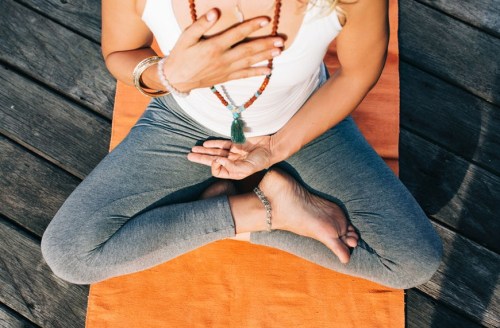Our editors independently select these products. Making a purchase through our links may earn Well+Good a commission
You’ve got your cardio-to-weight training ratio down to a science, you’re meditating on the reg, you’re eating all the adaptogens—and yet, you’re still dealing with bloating, anxiety, fatigue, or other nagging symptoms? Here’s something you probably never considered: It might be because you’re bad at breathing.
Yes, there is a “wrong” way to inhale and exhale. (As if we needed something else to be perfectionistic about, right?) And experts claim that bad habits in the respiratory department are more common than you’d think.
“Breathing is something we do 15,000 times a day, so what ends up happening is that it can become habitual in a positive or negative way,” explains Patricia Ladis, a physiotherapist and certified behavioral breathing expert. Many of our breathing patterns were picked up in childhood, she says—for instance, if you lived in a stressful home or had traumatic experiences at school, your adult self may be more prone to unconsciously hyperventilate or hold your breath when you’re in tense situations. Other people can develop disordered breathing in response to pregnancy, an injury, or chronic pain.
“Breathing [correctly] is like having a remote control to your entire nervous system.” —Poppy Jamie, creator of the breath work app Happy Not Perfect
When you start breathing correctly, there are a myriad of benefits. “Breathing [correctly] is like having a remote control to your entire nervous system,” says British entrepreneur Poppy Jamie, who just launched Happy Not Perfect, an app with breathing exercises created by neuroscientists and breathing experts. One of the most obvious is it can greatly reduce anxiety. “When you reach a breath rhythm of inhaling and exhaling for a count of five or more, it changes the nervous system, taking the body from the sympathetic nervous system—that fight-or-flight mode—to the parasympathetic nervous system, which is the digest-and-rest mode,” says breath work coach and Pilates instructor Maeve Yore, who owns Brooklyn’s Finetune Pilates.
Scientific studies show this switch lowers cortisol levels too, which boosts the immune system. Yore even had one client rid herself of asthma attacks after changing her breathing. Another stopped having allergy attacks. It helps with digestion, too. Studies link belly breaths to experiencing less heartburn and burping (hey, the struggle is real), IBS, and improving overall digestion.
The only way to know for sure whether your health issues are linked to your breath is to visit an expert like Ladis and get a personalized Rx. But, she says, there are certain respiratory imbalances that she sees over and over again, and it can’t hurt to give their fixes a try. Read on to learn how to give your lungs some love—and, perhaps, feel better in the process.
Here’s what to do if you think you’re breathing wrong—and the common pieces of advice that you shouldn’t heed.

Avoid taking deep breaths (yes, really)
We’ve all been told to take deep breaths when we’re stressed out. But according to Ladis, that’s often the worst thing you can do, since she sees many people in her practice who are already over-breathing by default.
“It doesn’t always look like hyperventilation,” she explains. “But you’re in this state where you’re blowing off too much carbon dioxide and sucking in too much oxygen and you’re not even realizing it.” If you notice yourself needing to take extra gasps of breath every once in a while—especially during stressful moments—chances are good that you’re an over-breather.
The antidote, says Ladis, isn’t to take even deeper breaths, but to work on making your breathing as quiet and soft as possible. “Bring your tongue to the roof of your mouth—this is the ideal position for relaxing the neck and the upper chest,” she says. “Then, with your mouth closed, gently breathe in and out through your nose, for anywhere from 2-5 minutes. Then, see how you feel.” If you’re better off than when you started, repeat daily so your body can reset itself and learn the new pattern. And if this exercise makes you feel worse, you’ll know that over-breathing probably isn’t your issue.
Don’t try to control your breath
In the midst of a sweaty sun salutation, yoga instructors often tell their classes to take slow, controlled breaths linked with their movement. And while this may be a good way to keep your mind off of your grocery list, it’s not always ideal from a behavioral breathing perspective.
That’s because some people are naturally more rapid, shallow breathers, says Ladis. And we should never shift too far away from our default. “Some people just breathe very quickly, but as long as they’re in the right range [of oxygen and carbon dioxide balance], I don’t mind,” she explains. “Those are the people that are like, I can’t do yoga or meditate, I always feel like crap when I do it.”
Instead, she recommends that everyone work to discover the natural reflex that kicks in at the end of an exhale when you need to take a breath—this will help you figure out what your natural breathing rate is. “What I often tell people is breathe in, and when you think you’re good, take a pause for a second and then exhale fully,” she says. “Wait at the end of your exhale, pause there for a moment, and see if you can sense this reflex that comes over you and lets you take your next breath. If you let it do its job, it will most likely take the most appropriate amount of air in.”
This reflex can be stifled if we’re under stress or consciously trying to control our breathing patterns. Training it for two to five minutes a day will allow your body to work more efficiently, says Ladis. “It does the work for you to keep a good internal chemistry that is appropriate for everything you need to do,” she says. “Get out of its way and you can strengthen your body’s response to your whole environment.” That’s some serious inspiration to work on your inhalation, no?

Breathe into your belly
“You don’t see this in every culture, but particularly in North America and Western Europe, we somehow got the breathing thing backwards,” Yore says. “Typically when we breathe, we inhale and suck our stomachs in when we should really be doing the opposite, expanding the stomach on the inhale,” she explains.
When you look at babies, they breath the deep, full belly breaths Yore described above. So why exactly do we turn into sucking in on the inhale later in life? The answer is a mix of lifestyle, societal pressure, and constantly living with low-grade anxiety. “From the time we are 5 years old, we go to school and sit hunched over a desk,” Jamie says. “As we get older, we breathe in and the breath goes higher into our chest. We’ve developed bad breathing habits and start breathing shallowly.”
But school and desk jobs aren’t the sole reason why we’ve become a country of bad breathers. Jamie and Yore both say many people suck in their stomach and breath shallowly—either consciously or unconsciously—because of societal pressure to look thin and not have their belly stick out. “I learned to breathe correctly in drama school when I was studying acting and classical singing. It was very hard for many of the actresses to let go of the societal pressure to suck in their tummies and look thinner than they really were,” Yore says. “But when you breathe correctly, not only does it help you relax and get rid of pre-show jitters, it allows the diaphragm to drop down and relax the abdominal muscles so you can project better and say 12 lines of text in one breath.”
Yore has many of her Pilates and breath work clients get more attuned belly breathing by lying on their back with their knees bent, with a book on their stomach.
Another reason why most people breathe shallowly: living with constant low-grade anxiety (and all too often, not-so low-grade). “We’ve become so used to being in a state of alert that we’ve almost become addicted to our stress,” Yore says. It was her own struggles with anxiety that led her to obsessively researching breath work, learning from one of the field’s leaders, Breathe author Belisa Vrancich, MD. She explains that if you think of someone having an anxiety attack, their breaths are fast and shallow. A less exaggerated version of that is the shallow, sucking-in inhales most people do involuntarily. The opposite of that: belly breathing.
Yore has many of her Pilates and breath work clients get more attuned to doing this by lying on their back with their knees bent, with a book on their stomach. “In addition to becoming so self-conscious about our tummies, we’ve become very cut off by them; some people literally can’t feel if they are allowing their stomach to move,” she says. “When you inhale correctly, pushing the book three or four inches up and let the book drop as you exhale, that weight allows you to feel it more.”
Making these small adjustments have huge payoff, these experts say—the power of proper breathing is literally life-changing. “We are our best selves when we are relaxed,” Jamie says. “When you’re in a state of relaxation, that’s when you can make balanced, better decisions that ultimately create the lives we want.” —Emily Laurence and Erin Magner
Here are more scientifically-proven ways to boost happiness. And if you want to start working belly breathing into a meditation practice, here’s how to find a meditation style that’s best for you.
Sign Up for Our Daily Newsletter
Get all the latest in wellness, trends, food, fitness, beauty, and more delivered right to your inbox.
Got it, you've been added to our email list.











